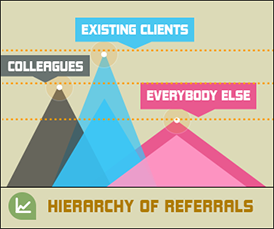There’s a myth that’s been floating around service business circles since the very first business hung out its shingle. You’ve likely had it cross your mind at some point, especially when you began your freelance writing career. What is this seemingly innocent, even logical idea that can pose a significant threat to your success as a freelance writer? It’s this:
“If I do good work, my clients will refer me to their colleagues, friends and associates”
In a nutshell, don’t count on it. Sure, it seems to make sense. But here’s a caveat—referring you won’t typically cross Mr. or Ms. Client’s mind. They might be doing the happy dance when you submit your eloquent, compelling prose. They may be singing your praises and telling you what a wonderful job you’ve done. However, a referral is at the bottom of their things to do list, if it made the list at all. There are several reasons for this and a fix for the quandary. As luck would have it, that’s what this article is all about.
There’s a truth in business and in life: If you don’t ask, you don’t get. It’s no different when it comes to client referrals. But, that asking requires some careful thought and preparation. A bit of style and panache doesn’t hurt, either.
The anatomy of a referral
Referrals are often ready-made business. As a matter of fact, RainToday.com’s 2009 study, How Clients Buy, showed referrals from colleagues and other service providers topped the list at 79% and 75%, respectively, outshining personal recognition/awareness (73%) and in-person seminars (66%).
Plus, referrals carry an endorsement from a third party. Your client’s or colleague’s trusted stamp of approval can set the prospect’s mind at ease and establish you as the right choice to fulfill the prospect’s needs.
The sales cycle
The time needed to nurture and build a business relationship that, ultimately, turns a prospect into a paying client is called the sales cycle. The typical sales cycle for business services is roughly six to eight months. A quality referral can reduce that to mere moments. Why? Buyers often find themselves with a fire that needs to be put out … right now. So, they scramble and call a few trusted associates for some professional fire extinguishing recommendations.
A source of business
Many service providers rely heavily on referrals. For some, it’s their only source of business. And here’s how it usually works. Mr. or Ms. Freelance Writer hangs out their shingle and tells a few friends and business associates that they’re open for business.
The associates, being the benevolent souls they are, want to help and spread the word around or provide some contacts for the writer. The writer makes a few calls and lands a gig or two. Soon, the phone starts to ring with a few more requests. Off our freelance writer goes into the merry world of self-employment.
Avoid this bad habit
The problem is that they’ve set up a behavior … a habit. They wait for the phone to ring. As mentioned, they think, “If I do good work, people will refer me to others.” Sure, your clients might think you’re the bee’s knees while you’re working on a project and shortly thereafter. But, soon they forget about you until they need your services again. This non-marketing marketing method may be just peachy for a while. Eventually, the phone stops ringing and Mr. or Ms. Freelancer begins to get a wee bit anxious, if not completely freaking out.
The truth be told, even in good times, waiting for the phone to ring is a bad idea. It’s simply letting your business happen to you, rather than you making things happen. A better idea is to have a system in place to ensure those referrals keep rolling in and that they’re quality referrals.
Not all referrals are created equal
 Many times, a referral is just a name and a phone number or email address. The person who owns that phone number may or may not need your services. Perhaps they can’t afford your fees or they’re a complete lousy fit for your business. It might also be that the person making the referral isn’t known very well by the prospect, so there may be a lack of trust and/or credibility.
Many times, a referral is just a name and a phone number or email address. The person who owns that phone number may or may not need your services. Perhaps they can’t afford your fees or they’re a complete lousy fit for your business. It might also be that the person making the referral isn’t known very well by the prospect, so there may be a lack of trust and/or credibility.
There’s something of a hierarchy when it comes to referrals. Our existing clients, those who’ve experienced working with us first hand, are at the top of the list. Next come colleagues we’ve worked with on various projects. They’ve also experienced working with us, but from a different point-of-view. Then, there’s everybody else. So, it’s probably a good idea to focus your efforts on clients and project colleagues and then fill out your efforts with others in your business and personal networks.
Getting the right type of referrals
Educate clients
A large part of your referral system should be educating your clients and colleagues as to what you’re looking for when it comes to referrals. How do you qualify prospects? That’s the info you need to communicate to potential referrers. Your list might include the type of project, industry, size of the prospect, whether they can pay your lofty fees, location and similar information.
Be specific
Some folks fear that by getting too specific, they run the risk of closing the door on referrals. Not so. In fact, the more clearly you can define what you’re seeking, the easier it is for folks to refer you to the right contacts. If you’re too vague or broad in describing what you’re seeking, your contacts will struggle to match you with their contacts.
Also, generalities can erode your positioning. If you say, “Any small to mid-size company is a prospect for me!” Your contact hears, “I’m really benign and vanilla. There’s really no good reason to hire me over the other freelancer.” This is especially important to consider for associates who haven’t worked with you directly.
Define your leads
In as much as referrals are something of a numbers game, do what you can to define those numbers as high quality and likely to yield results. It makes little sense to spin your wheels chasing a lead you’ll never close or is a bad fit.
Going beyond the phone call
Don’t forget to tap into the social scene for possible referrals. If there are some prospects you’d like to work with, check your LinkedIn network to see if any of them have a contact in their network. A carefully crafted message may just do the trick. It might go something like this:
Hi Bob,
I noticed that Jack Sprat of Eat No Fat Corp. is one of your LinkedIn contacts. I’ve been researching them and it looks like they would benefit from an email marketing campaign like the one I recently completed for you. Would you be willing to make an introduction?
Thanks! Also, we need to get together and catch up. Lunch is on me. Let me know where and when is good for you.
Utilize social media

Also check your clients’ and colleagues’ Facebook profiles and pages, along with Twitter followers. Your efforts might just glean some great contacts.
In addition to social media, consider asking a colleague to bring a potential prospect to one of your presentations or seminars. Or, it could be as simple as the getting the three of you together to break some bread (on you, of course).
Alternatively, consider using some case studies in an email campaign. (You can find tips on how to set this up on InboxArmy.) They should be in a problem / solution / result format. At the end, add in something along the lines of, “Perhaps you or a colleague would benefit from a similar project. If so, give us a ring or email and let’s talk.”
Setting referrers at ease
Getting potent referrals requires a couple of other things. First, you need pleased-as-punch clients. So, do great work and always strive to under-promise and over-deliver.
It’s important to note that giving a referral can often involve a lot of risk on the part of the referrer. They need to be assured that you’ll do as good a job, or better, for their contact as you did for or with them. Your request puts their reputation on the line.
Yet, for some clients, even though you’ve done a stellar job, they may feel more than a bit awkward in talking you up to their contacts. Even worse, they may feel like you’re putting them in the position of being a non-paid salesperson for you.
 To ease their mind, consider, as mentioned earlier, having your client bring their contact to an event you’re hosting or featured at, such as being the speaker. Now there’s some value attached to the introduction.
To ease their mind, consider, as mentioned earlier, having your client bring their contact to an event you’re hosting or featured at, such as being the speaker. Now there’s some value attached to the introduction.
The power of giving
If you find yourself event-less, a special report or white paper you wrote, or can write, or some other special information can also work. It’s a matter of finding a method to authentically add value so the referrer isn’t feeling like you’re putting them on the spot.
Plus, it can also be awkward, let alone ineffective, to unexpectedly spring a referral request on people. When a person is unprepared for the request, it’s tough for them to come up with quality contacts right on the spot. Give them a chance to mull it over by preparing them first. During the course of the gig, providing it’s going well, ask them how they feel the project is progressing. Is it what they expected? Can anything be done to improve things? Finally, ask them if it would be
During the course of the gig, providing it’s going well, ask them how they feel the project is progressing. Is it what they expected? Can anything be done to improve things? Finally, ask them if it would be okay to, at a later date, talk with them about others they know who might also benefit from your services. This gives them a chance to think things over and come up, usually, with several contacts that fit your ideals.
Timing your requests
It’s said that timing is everything and it’s no different when it comes to referrals. Obviously, the best time to approach a client or colleague for referrals is at the end of a successful project. You’re fresh on their minds. You’re a star for pulling off some amazing feat.
Consider making a follow-up meeting part of your project process. Although you may have discussed it during the project, ask what they felt went well and what could use improvement. Ask if their expectations were met. Also ask for any specific results they can share about the project. This is handy info for developing case studies.  Solid, quantified results give a much sharper edge to case studies.
Solid, quantified results give a much sharper edge to case studies.
Then ask them who they may know that would also benefit from your services. After they just told you all the high points of working with you and the incredible results your skills brought to them, singing your praises to others is the next logical step. Manipulative? Sure. But often it’s important to guide your clients and colleagues along a path to get the right type of referral.
Marketing for referrals
Finally, make the quest for referrals a regular part of your marketing mix. Add these tasks to your calendar and set up reminders. Develop materials your potential referrers can use to provide value in making referrals. Do what you can to ease referral anxiety on the part of your contact.  Scour LinkedIn and other social media site for connections. Whenever possible and appropriate, educate your clients, colleagues and contacts as to what you’re looking for in prospects and referrals.
Scour LinkedIn and other social media site for connections. Whenever possible and appropriate, educate your clients, colleagues and contacts as to what you’re looking for in prospects and referrals.
Whenever possible and appropriate, educate your clients, colleagues and contacts as to what you’re looking for in prospects and referrals.
It may take some time to get your referral system up and running like a well-oiled machine. But, it sure beats sitting at your desk playing Solitaire while waiting for the phone to ring.
About the Author
Neil Tortorella is a graphic designer, writer and marketing consultant with over thirty years experience. He is the author of Starting Your Career As A Freelance Web Designer, Starting Your Career As A Musician and The Freelance Writer’s Business Book. Tortorella is a frequent speaker at conferences and business events. His writing and consulting site can be found at www.neiltortorella.com.



